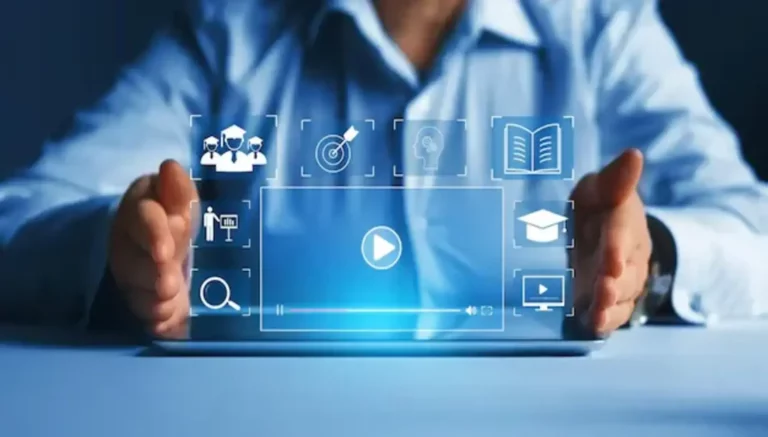
In Education, the integration of innovative tools into the classroom environment is known as educational technology. This approach aims to enhance and optimize the learning experience for students by leveraging the potential of new technologies. Educational technology seeks to transform traditional teaching methods and create a more engaging, interactive learning environment.
The adoption of education technology in the classroom covers a wide range of tools and techniques. These can include Interactive whiteboards, Tablets, Smartphones, Educational apps, Online learning platforms, Virtual Reality (VR) Simulations, Augmented Reality (AR) applications, and many others. Each of these tools brings unique advantages and capabilities to the table. It provides educators with a lot of options to enrich their teaching practices.
Education technology or ed tech, empowers educators to deliver information in a manner that optimizes learning retention and effectiveness. Tools aid educators with multimedia to visually present complex concepts, making learning interactive and stimulating. This multisensory approach captures students’ attention, fosters their curiosity, and facilitates better comprehension and retention of information.
As ed tech continues to advance, it presents endless possibilities for educators to create innovative and immersive learning experiences. It equips the students with essential skills and prepares them for a future in which technology plays an integral role.
Educational technology has witnessed a multitude of emerging trends that are changing the learning experience for students. Two noteworthy advancements in this field are the proliferation of Internet of Things (IoT) devices and the integration of Artificial Intelligence (AI) systems. These interactive technologies have successfully infused classrooms with innovation and provided students with a more engaging and interactive learning environment.
Why is Education Technology important?
Modern education integrates the Internet, and computers alongside traditional tools like textbooks and pencils in educational institutions. This shift offers numerous opportunities to enhance academic performance through ed tech, and the utilization of educational technology. Leveraging devices, educators gain insights into students’ needs, enabling personalized solutions and addressing unique learning requirements.
The advent of technology in classrooms has changed the way educators approach teaching. It has opened up new ways for student engagement. One notable advantage of incorporating technology is the introduction of auto-grading systems. This innovative feature reduces the burden on educators. It can automate the grading process, enabling them to allocate more time to other essential tasks.
The integration of technology into the lives of students has become pervasive. It has created a significant opportunity to harness its potential in enhancing their education. Learners no longer desire to be mere recipients of information in a passive learning environment. Instead, they seek dynamic and interactive educational encounters.
Benefits
Accommodate various learning styles
Accommodating various learning styles in the classroom can be a complex task, but educational technology is useful in addressing this challenge. By integrating technology into teaching practices, educators can tailor their lessons to cater to the individual needs of students. For instance, interactive educational software or online platforms can offer visual, auditory, and kinesthetic learning opportunities. Visual learners can benefit from visual aids, such as infographics or videos, that enhance their understanding and retention of information. Auditory learners can engage with audio recordings or podcasts that present content in a spoken format, allowing them to absorb information through listening. Meanwhile, kinesthetic learners can benefit from interactive simulations or virtual experiments that provide hands-on experiences. The incorporation of various technological tools empowers educators to create a learning environment that accommodates different learning styles and optimizes the educational experience for all students.
Enhanced Collaborative Abilities
Education technology expands and enhances collaboration among students both within and beyond the classroom setting. By integrating technology tools and platforms into their teaching practices, educators can create opportunities for students to collaborate effectively and develop essential skills for the 21st century.
Education Technology can facilitate communication and interaction among students, regardless of their physical location. For example, video conferencing platforms like Zoom or Google Meet enable students to engage in virtual meetings, discussions, and group activities, breaking down barriers of time and space. This technology empowers students to work together on projects, exchange ideas, and provide feedback to their peers, fostering a sense of teamwork and cooperation.
In addition to real-time communication, technology also provides students with collaborative tools and platforms that allow for seamless sharing and editing of documents, presentations, and other project materials. Cloud-based platforms like Google Drive or Microsoft Office 365 enable students to create, edit, and collaborate on documents simultaneously, promoting a more dynamic and interactive collaboration experience. Students can contribute their ideas, provide input, and make real-time changes, facilitating a more cohesive and synergistic group effort.
Enhanced bond between Students and Teachers
Recent research findings reveal that a significant proportion, approximately 57%, of educators recognize the influence of the internet on students’ capacity to express their thoughts and ideas to their teachers. The advent of technology has changed the educational landscape, facilitating seamless communication and fostering stronger bonds between students and their instructors. With the introduction of digital platforms and online tools, students now can submit assignments, engage in interactive discussions, and seek guidance from their teachers, all with just a few clicks or taps.
The impact of technology on student-teacher connections goes beyond the mere convenience of online communication. It has fundamentally transformed the dynamics of classroom interactions. In the past, face-to-face discussions were often constrained by time and physical boundaries. However, with the integration of technology, geographical limitations are no longer a hindrance. Students from diverse locations can engage in real-time conversations, sharing their ideas and seeking feedback from their teachers, fostering a more inclusive and collaborative learning environment.
The digital world offers a multitude of channels for students to express themselves creatively and intellectually. Online platforms provide forums, discussion boards, and virtual classrooms where students can showcase their knowledge, perspectives, and unique insights.
Readiness for the Future
Incorporating the latest technologies into various industries has become commonplace, and possessing proficiency in technology can greatly facilitate students’ transition into professional settings. When students are accustomed to working with technology during their schooling, they can effortlessly transfer that familiarity to job-oriented software applications. By integrating technology within the classroom, educators can equip students with the necessary skills and knowledge that will contribute to their future career success.
Integrating technology in the classroom cultivates critical skills that are in high demand in the job market. Students develop problem-solving abilities, adaptability, and digital literacy, enabling them to effectively steer and leverage technology-driven workflows. They gain experience in collaborating virtually, communicating through digital platforms, and utilizing online resources for research and analysis. These skills not only enhance their academic performance but also provide a solid foundation for future professional ambitions.
Current Educational Trends
Staying abreast of the latest trends in educational technology has become crucial for teachers in today’s fast-paced world. Embracing cutting-edge technology not only enhances the learning experience for students but also relieves educators of mundane tasks.
Education Trends
E-learning
The worldwide closure of schools to mitigate the spread of the COVID-19 virus sparked a significant transformation in the field of education. As traditional classroom-based learning became untenable, educators and students turned to e-learning platforms as a viable alternative. This shift towards distance learning gave rise to an unprecedented surge in the demand for online educational solutions, propelling e-learning platforms to the forefront of educational trends.
E-learning platforms offer a wide range of benefits that make them highly appealing in the context of remote education. By leveraging the power of technology, these platforms enable educators to deliver educational content in a flexible and accessible manner. Students can access learning materials, engage in interactive activities, and participate in virtual classrooms from the comfort of their own homes. The use of e-learning platforms also empowers learners to set their own pace, allowing them to customize their learning experience according to their individual needs and preferences.
E-learning platforms facilitate the seamless integration of multimedia elements into educational content. Through the use of videos, interactive simulations, gamification, and other multimedia tools, these platforms create engaging and immersive learning experiences. This not only enhances students’ understanding and retention of the material but also promotes active participation and collaboration among learners.
Another significant advantage of e-learning platforms is their compatibility with a wide range of devices. Whether it be smartphones, laptops, or computers, students can access educational content anytime and anywhere, as long as they have an internet connection.
In addition, e-learning platforms offer features that facilitate personal learning. These platforms often employ intelligent algorithms and data analytics to track students’ progress and provide recommendations and feedback. This learning approach allows educators to tailor the learning experience to each student’s strengths, weaknesses, and learning styles, fostering better learning outcomes.
Blockchain Technology
Blockchain technology is transforming the education sector by providing a novel approach to data storage and record-keeping. It operates by structuring data into blocks that interconnect to form an immutable and transparent chain known as the blockchain. In this context, blockchain’s impact on education is particularly prominent when it comes to storing and managing student credentials and certificates, addressing issues such as fraud, data security, and plagiarism.
One of the most remarkable transformations brought about by blockchain technology is the streamlining of record-keeping for student qualifications. By leveraging blockchain, the cumbersome process of verifying degrees and academic papers is rendered obsolete. Instead, educational institutions can rely on transparent and tamper-proof ledgers to validate the authenticity of credentials, mitigating the risk of workplace fraud.
The characteristics of blockchain, such as its immutability and transparency, play a pivotal role in promoting honesty and accountability in academic qualifications. Once information is recorded on a blockchain-based ledger, it becomes exceedingly difficult to modify without the consensus of network participants. This inherent security feature of blockchain technology ensures the integrity and security of educational data, effectively combatting issues like data tampering and unauthorized alterations.
Blockchain has the potential to address the pervasive problem of plagiarism in the education sector. By storing all educational data on a blockchain platform, the decentralized nature of the technology makes it nearly impossible to modify or tamper with records without proper administrative access. This heightened level of security and immutability acts as a strong deterrent to plagiarism, preserving the authenticity and originality of academic materials.
Artificial Intelligence
The integration of artificial intelligence (AI) into education technology brings forth promising applications, particularly in automating grading processes and providing individual learning experiences for students. By leveraging AI, activities such as grading multiple-choice questions and completing fill-in-the-blank exercises can be efficiently executed without requiring direct involvement from educators. This automation not only saves time for teachers but also allows them to allocate their efforts toward other essential tasks and priorities.
AI addresses the challenge of providing individual attention in overcrowded classrooms. By harnessing the power of AI, personal tutoring becomes a viable solution for students who require additional support. AI programs can adapt to individual learning needs, creating tailored learning tracks for each student. This approach enables students to learn at their own pace, reducing the frustration often associated with traditional teaching methods. With AI, students have the opportunity to explore educational content at a comfortable speed, fostering a more engaging and effective learning experience.
Gamification
Educators constantly seek ways to make learning enjoyable, and gamification has emerged as a promising solution. Gamification involves incorporating game-like elements into everyday activities to enhance student engagement, particularly in primary education. By combining learning with fun, students can engagingly acquire valuable knowledge
The implementation of gamification not only prevents boredom but also offers numerous benefits, including fostering cognitive development in children.
Augmented reality (AR) and Virtual Reality (VR)
Augmented reality (AR) and virtual reality (VR) have the potential to enhance classroom interactivity and immersion, meeting the expectations of modern students who seek novel experiences. Immersive learning, which engages multiple senses, can be achieved through these technologies. While VR creates a simulated reality, AR offers an enhanced view of images.
Immersive learning enables students to explore environments and enjoy an engaging educational experience. Making abstract concepts more tangible, helps students grasp them more easily. Through hands-on participation in experiments and virtual visits to historical sites, lessons can be brought to life, directly impacting student performance in the classroom.



